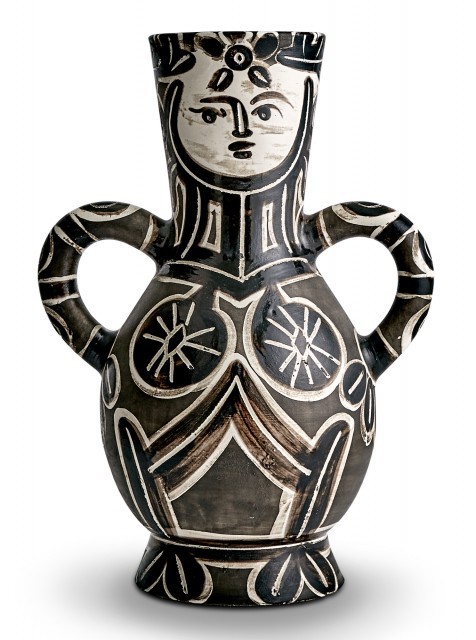Ceramics by Pablo Picasso
10/22/2022 Prints & Multiples

NEW YORK, NY -- Prints and ceramics by Pablo Picasso provide a wonderful opportunity for collectors to purchase works of art by one of the most innovative, prolific, and celebrated artists of the 20th century for a fraction of the price of his paintings.
While Picasso had been making prints since 1904, it was not until later in life that he became entranced with creating ceramics. While residing in the south of France in 1946, Picasso attended the first annual pottery exhibition in Vallauris. Though the village has a history of pottery-making dating back to Roman times, local interest in the craft had declined. One of the exhibitors was the Madoura workshop owned by Georges and Suzanne Ramié. In 1936 they had purchased a complex of old buildings and a wood-fired kiln from a closed facility in Vallauris, where they produced plates and art pottery. Picasso was enamored with the Ramiés’ pottery at the show, prompting a trip to their studio. On his first visit to Madoura, Picasso created three small objects: two bulls and the head of a faun. This experience made a strong impression on the artist. He returned the following year with numerous illustrations of ideas he wanted to realize in ceramic form. The Ramies were delighted to welcome Picasso back and provided him with an area in which to work. Though the artist had first worked in clay forty years earlier, it was not until he came to Madoura that ceramics truly captured his imagination.
Picasso welcomed the idea of making multiples from his unique ceramics, generally in editions of 50 to 500, and was pleased that they would be affordable to a wide audience. Over the next 24 years, he created approximately 3,500 unique ceramic objects and authorized the Ramiés to produce more than 633 numbered editions of his work. It was at Madoura in 1953 that he met his second wife, Jacqueline Roque, of whom he created more works of art than of any other woman. She was the subject of many of his ceramics, such as the large double-sided plate Jacqueline au Chevalet from 1956 (lot 160) and Chope Visage pitcher from 1959 (lot 163).
Picasso embraced pottery-making with the same zeal he had for painting, drawing and printmaking. This resulted in a prodigious creative output that characteristically broke through preexisting boundaries. Picasso playfully incorporates the three-dimensional nature of the medium into the design. Utilitarian pieces such as pitchers are transformed into sculptural objects, the entire body metamorphosing for example into owls (lot 153) and faces (Lot 163 and Lot 167) and even full figures of which the monumental Vase Deux Anses Hautes is a fine example (lot 156). The face was one of Picasso’s most popular subjects in all artistic media, as illustrated in several of the plates and pitchers in this sale.
Picasso belied the three-dimensionality of ceramic in many of his plates, chargers, and plaques, depicting a flattened image of a traditional painting subject head on suggesting a work on canvas or paper. He created the image of some, including Corrida (lot 155), Vase au Bouquet (lot 157) and Scène de Tauromachie (lot 162) as he would an etching or drypoint, using a tool to carve the lines; however, instead of an etching needle on metal, he used unconventional items such as a kitchen knife to cut into a plaster mold, which was taken from an existing piece of pottery. Impressions could thus be taken from the plaster matrix to create editions, referred to as Empreintes originales, and bearing the Empreinte Originale de Picasso Madoura pottery stamp.
Created by Picasso late in his career, these 16 extraordinary ceramic objects (lots 153-168) provide us with yet another glimpse into the artistic vision of one of the greatest artists of the 20th century.
Prints & Multiples
Auction Wednesday, October 26, 2022 at 11am
Exhibition Oct 22 - 24
The upcoming auction offers a fine selection of Picasso editions in a wide range of values (lots 141-168).